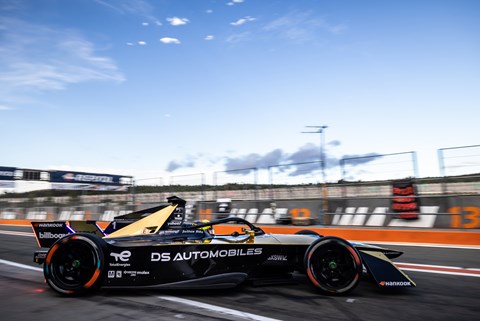► Formula E vs EVs – where’s the connection?
► CAR talks to the DS Penske team
► DS says tech has been carried across from sport to road
Car makers have claimed that involvement in motorsport means tangible benefits for its road cars. Formula 1, the World Endurance Championship, WRC have all meant real technological development for passenger cars (and even whole new road cars required for homologation purposes), for example. And, for a little while now, manufacturers involved in Formula E claim the same.

Take DS, for example. The premium French brand has found success in the sport since its inception, including two team championship titles in the 2018 and 2019 season, and three drivers’ championship titles between 2017 and 2019 with its DS Techeetah team. Its new DS Penske team shows the brand is still committed to the sport, with the brand still seeing value in being a part of it.
Then-boss of DS, Beatrice Foucher, told CAR in late 2022 that the DS team’s involvement meant more than the brand being in front of more eyeballs: ‘It is absolutely a tool for marketing, yes,’ she says, ‘because you can communicate based on your success. For example, we’ve beaten Porsche, Mercedes-Benz and Audi – that’s big. But we have the DS Performance team who is really willing to create something with our production cars using Formula E technology.’
 Credit: Alex Tapley
Credit: Alex Tapley
In Formula E, there is a little wriggle room for each team’s car to be modified or refined beyond the base foundation of the current Gen3 car. For those teams with OEM sponsors or branding (like DS, Nissan, Porsche, Nio and Cupra in the latest season), they can prioritise development on tech and engineering in stuff that benefits them out of the sport. Charles-Henri Bonnet, marketing and events boss at DS Performance, told CAR during the 2023 London E-Prix: ‘it’s important for us as a manufacturer to focus on what’s important and what’s relevant for us. Developing a carbonfibre chassis? We don’t care. It’ll cost us a lot of money and won’t bring anything to the brand. Instead, we must make sure we provide the most efficient and most reliable electric powertrain we can for electric cars, and that’s what we can learn here.
‘Not only do we learn about the hardware, though, we learn about energy management. Electric mobility is all about it,’ Bonnet adds; ‘We are not British Petroleum, we are not Total Energies – we’re not going to make our own charging stations. What we can do, however, is helping our customers manage their energy – how you spend it and how it’s regenerated. In Formula E, it’s all about energy management.’
And Bonnet’s right. Each of the drivers has to keep a close eye on battery charge remaining, including when to use the car’s ‘attack mode’ for an extra power boost (at the sacrifice of additional charge), and all normal braking is done through regeneration.
 Credit: Malcolm Griffiths
Credit: Malcolm Griffiths
‘There are a lot of similarities,’ says DS Penske team driver (and two-time Formula E world champ) Jean-Eric Vergne when comparing Formula E to road car driving; ‘we develop all our own software within the team that allows us to gain energy back in recuperation. We’re putting a lot of the findings we get in motorsport into the E-Tense cars [DS’ range of plug-in hybrids and EVs] to try and make the battery last longer.’
‘It’s quite funny going between our racing cars and our road cars,’ adds fellow DS Penske team driver (and 2022’s Formula E world champion) Stoffel Vandoorne, ‘because that regen in the road car almost feels like what you’d get in a racing car.’